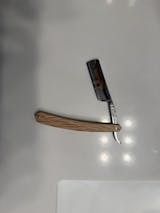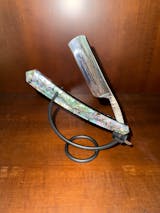As modern gentlemen, we often do not enjoy the luxury of a good shave, an irresistible treat we could never pass up. Learning how to use shaving soaps is the secret to getting a close shave that rivals a barber's. This skill allows us to create a lather of the ideal consistency, protecting our skin from the abrasiveness of the razor blades of safety razors and straight razors.
With this knowledge, we can achieve impeccable grooming in the comfort of our own homes, focusing on things that provide convenience over luxury while still indulging in the pleasure of a luxurious shave.
From one gentleman to another, let me introduce you to the art of using shaving soap. From choosing the right soap for your grooming needs to all the expert techniques you should not miss.
Can you shave without shaving soap?
Shaving soaps have been around since the 14th century and have been the standard for use in barbershops and the homes of many men. But shaving soaps became less popular as convenience took precedence over the traditional grooming ritual.
Even without shave soaps, you can achieve a wet shave with canned creams and gels, which offer a quick alternative. But none can truly rival the quality of lather that traditional shaving soap provides. The use of shaving soap offers numerous benefits that elevate your routine and treat the skin with care.

What makes a shaving soap better than cream and gel?
Shaving soap, a traditional grooming product, is a hard soap specifically formulated to create a luxurious lather that provides excellent lubrication, cushioning, and protection during shaving. Made from natural ingredients such as oils, fats, and glycerin, shave soap offers a rich and creamy texture that enhances the overall shaving experience.
From enhanced lubrication to better moisturization, natural shaving soaps surpass shaving creams and gels in delivering a superior shave that pampers your skin because they have:
- No Artificial Additives: There are no artificial additives, ensuring a more natural, gentle, and non-irritating soap without compromising scents or moisturization, perfect for normal to sensitive skin types.
- Natural Glycerine: These soaps' natural glycerine creates a stable and stiff lather that creates a protective barrier while shaving.
- High-Fat and Low Alkalinity: Formulated with high-fat content and low alkalinity, shaving soap produces a stable and stiff lather for improving lubrication, minimizing irritation, and reducing razor burn.
What makes shaving soap better than shaving creams, gels, canned foams, or a normal soap is its reliance on natural ingredients and properties to produce a foamy and thick lather. Shaving soaps prioritize mildness and reduce irritation and razor burn by utilizing ingredients like glycerine, high-fat content, low alkalinity, and anti-bacterial and anti-inflammatory properties for a milder and gentler alternative for the skin than shaving foam, cream, gel, and regular soap.
Benefits of using shaving soaps
A good shaving soap elevates your shaving routine with a range of benefits, particularly regarding lather quality and preventing dry skin. Here are some key differences:
Lather Quality:
- Shave soap produces a richer, thicker, and more stable lather.
- The thick lather offers superior cushioning and protection for smooth razor gliding.
- It holds moisture, keeping hair hydrated and ensuring a smoother shave.
- The lather improves visibility, reducing the chances of missed spots or uneven shaving.
Enhanced Lubrication and Protection:
- Shaving soap provides a smooth surface for the razor to glide over.
- It reduces friction, minimizing the risk of razor burn and irritation.
- The soap allows the razor to cut through the hair for a closer shave effortlessly.
- It adds a protective layer, reducing the likelihood of nicks, cuts, and ingrown hairs.
- Shaving soap delivers enhanced lubrication and protection throughout the entire shaving process.

How To Use Shaving Soap
Men have been used to the ease and convenience most modern shaving tools offer that using shaving soap for wet shaving, alongside using a straight razor, has become a skill that they deem hard to master. Wet shaving, similar to other lathering methods, is a simple process that involves mastering a few basic techniques.
Things You'll Need
To effectively lather shaving soap, you'll need the following items:
- Shaving brushes: A clean brush with soft and natural bristles is ideal for creating a rich lather.
- Shaving soap: Choose a high-quality shave soap that suits your skin type and preferences.
- Warm water: For making the brush wet and to soften the soap.
- Shaving soap bowl or shaving mugs: An optional item for lathering and holding the soap.
Blooming
- Wet the shaving brush: Run the brush under warm water to fully wet the bristles.
- Shake off the brush: Gently shake it to remove any excess water, leaving it slightly damp.
- Prepare hot water: Fill the bottom chamber of a scuttle with hot water to create a warm lathering environment.
- Soak the soap: Pour some warm water over the soap inside the scuttle or bowl, allowing it to soak and soften for a few minutes.
- Bloom: Let the water in the bottom chamber of the scuttle or the shaving bowl heat the soap, promoting easier lathering and a more comfortable shave.

Lathering and Applying
- Swirl the brush on the soap: Press the damp brush onto the surface of the shaving soap. Apply moderate pressure and swirl in a circular motion to load the brush with soap.
- Work the lather: Transfer the soap-loaded brush to a shaving bowl or mug. Use circular or back-and-forth motions to whip the soap into a rich lather. Add a small amount of water as needed to achieve the desired consistency.
- Apply the lather: Use the lather to map your face, following the direction of your hair growth, and apply it with the shaving brush in gentle, circular motions to achieve even distribution and complete coverage.
- Allow the lather to sit: Let the lather sit on your face for a minute or two to soften the hair and provide lubrication.
Keeping your scuttle or bowl warm and blooming your shaving soap is the key to efficiently creating a luxurious lather for a smooth and comfortable shaving experience.

Other Ways to Use Shave Soap
Wet shaving beginners may not have a complete arsenal of gear without a shaving brush, scuttle, or bowl just yet. However, if you learn to use shaving soap on your hands and face, along with a shaving brush, you can still achieve a good lather.
Palm Lathering
This method works best with puck-style shaving soaps rather than tins. To work up a lather with a shaving soap puck using only your hands, you should:
- Wash your hands to ensure they are clean and don't have any oil or lotion.
- Cup the soap in your palm and apply water to bloom the surface.
- Rub your palms with the softened and bloomed soap until you have the right amount and consistency of lather for your shaving needs.
Apply it to your face and shave as usual.
Face Lathering
In addition to lathering with your hands, you can also lather shaving soap on your face by following these steps:
- Bloom the soap and soften it with some water.
- Rub the soap on your wet face using gentle, circular motions.
- As you rub the soap, add a few drops of water to the lather to maintain its consistency.
- Keep rubbing the soap gently on your face until you achieve a rich and creamy lather.
- Proceed with shaving, using the puck-lathered soap on your face as a lubricant.
Using Soap Tin And Brush
If you own a shaving brush, a scuttle or bowl isn't strictly necessary to make a lather. The alternative is to:
- Bloom the soap by adding a few drops of warm water to its surface.
- Swirl the brush in circular motions, adding water as needed, until you reach the consistency you need.
- Once the lather is ready, scoop it out of the tin with the brush and apply it to your face using a circular motion, ensuring even coverage.
Remember that you can use these techniques instead of the standard brush and bowl method if you are in a bind without them. Learn what works best for you and savor the pampered experience of shaving with soap by trying various approaches.

Common Shaving Soap Irritants To Avoid
To ensure a high-quality shaving soap, it's important to avoid certain ingredients that can cause skin irritation or allergies. Here are some common irritants and potential allergens to avoid:
Fragrances and artificial dyes:
- Synthetic fragrances can cause skin irritation and allergies.
- Artificial dyes may also lead to skin sensitivity and irritation.
Harsh chemicals and preservatives:
- Propylene glycol, often a moisture preservative, can dry and irritate.
- Triethanolamine (TEA), an emulsifying agent, has the potential to cause skin sensitivity.
- Mineral oil, a petroleum byproduct, can clog pores and hinder natural oil production.
Synthetic foaming agents:
- Sodium Lauryl Sulfate (SLS) and Sodium Laureth Sulfate (SLES) are common detergents and lathering agents that can strip the skin of moisture.
The best shaving soap will keep the skin lubricated and soft to prevent razor burns and nicks. So, read the label regularly and look for all-natural ingredients to avoid skin irritation and reap the full benefits of your shaving soap.
Key Takeaways
You should have it figured out by now. Learning how to use shaving soap for traditional wet shaving is not rocket science and can be accomplished by anyone. Whether you have a few tools or none, you can whip up a lather that will provide you with the closest, smoothest, and best shave you've ever experienced.















